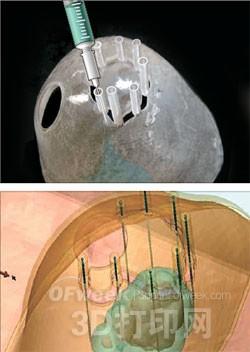According to Korean media reports, the Korean domestic medical team has taken the lead in developing a technology that uses 3D printers to improve the accuracy of breast cancer surgery.
According to reports, Professor An Shizhen, Gao Fanxi (sound) professor of the Department of Breast Endocrinology, Lushan Hospital, Seoul, Korea, and Professor Jin Nanguo (Sound) of the Department of Fusion Medicine announced on January 5 that they successfully used 3D printing in breast cancer resection. The surgical guidance module (model indicating the surgical site) tailored for the patient accurately cuts off the cancerous site.

The expert uses the 3D printer to make the model for the patient (top) and the dyeing agent is injected into the corresponding part through the pigment injection port on the model, and the cancerous part will be colored, so that the resection area is controlled to the minimum range (below) .
The research team said that the magnetic resonance imaging (MRI) results were first input into a 3D printer to create a model that fits perfectly into the patient's breast. The model has an injection port for the doctor to accurately inject the pigment at the site of the cancer cell. The injection port injects the human body with the dyeing agent into the corresponding part, and the surface of the cancerous cell is accurately colored, and then the surgery can accurately remove the cancerous part.
It is reported that the research team obtained the formal permission of the Korea Food and Drug Safety Division in December last year for the use of the surgical guidance module, and thereafter applied the technology to the preoperative anticancer treatment of three patients.
In the past, when breast cancer surgery was performed, the patient's breast was partially anesthetized before surgery, and then the ultrasound was used to locate, and more than 10 thin fine needles were inserted into the cancerous site, and the parts to be removed were marked.
According to the report, in this case, considering the error of the ultrasonic examination, the surgical removal site tends to be larger than the actual cancerous site, and the patient often feels pain and discomfort when inserting the fine needle.
Recently, many patients undergo anticancer treatment before surgery to reduce the cancerous site, and after the anticancer treatment, the cancerous site generally becomes difficult to be recognized by the naked eye. Although magnetic resonance imaging can detect the location of cancer cells, there is no way to mark them out. The evaluation concluded that the new surgical approach well overcomes this bottleneck.
Professor Gao said: "The key to breast cancer removal surgery is to completely remove the cancer cells, and to maximize the retention of the patient's breast tissue, as far as possible does not affect the quality of life after surgery. This surgery can only rely on lower accuracy. Ultrasound examinations have many limitations, and the accuracy of surgery has been greatly improved by using 3D printers."
Deodorant Natural,Deodorant Quotes,Deodorant Brands,Deodorant Under Breasts
Guangzhou Suzhi Biotechnology Co.,Ltd , https://www.sojobiotech.com